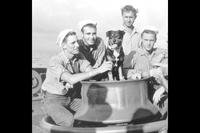The Smithsonian Channel is airing a new eight-part series called "The Pacific War in Color" that chronicles the conflict with rare and never-before-seen color visuals. It's on Sunday nights at 8 p.m. ET/PT.
There have been "color" programs about World War II before but almost all of those documentaries relied on computer-colorized images to lure in viewers who won't watch black-and-white movies. The Smithsonian Channel has tracked down footage shot on color film and the difference is startling.
The network enlisted the resources of the National Museum of the Pacific War, located in Admiral Chester Nimitz's hometown of Fredericksburg, TX, to help tell the stories captured in the documentary series from the museum's extensive library of oral histories recorded by the men and women who lived through the conflict.
We had a chance to speak with the museum's Associate Archivist and Librarian Chris McDougal about his organization's role in making "The Pacific War in Color" and how the National Museum of the Pacific needs your help in locating men and women still around to tell their stories.

Can you explain the mission of the museum and how a National Museum of the Pacific War end up in Fredericksburg, Texas?
Our mission is inspiring our youth by honoring our heroes. The museum is here because of Admiral Nimitz and was established in the mid-60’s by some local townspeople with Admiral Nimitz’s blessing.
Have you had a chance to see any episodes from the new series?
No, I haven't. But I don’t know if you're aware, the series actually began with "The Battle of Okinawa in Color," which was aired last year. It was just a standalone episode and it ended up doing so well they added seven more episodes.
Can you describe your museum’s role in creating these new episodes and the original documentary?
We have an oral history program here that began in 1988. We have been steadily accumulating oral histories since then and right now we have approximately 5,000. 2,100 of those are online, available through our online repository.
Dan Wolf with the Smithsonian discovered our repository, which is very user-friendly. He was able to find a lot of oral histories that fit that initial Okinawa episode. When they expanded, our archive fit everything they were looking for. Smithsonian needed me to fact check and do some research about the individuals that they identified so they could use their material.
Which sounds like an incredibly fascinating job. What's your career background and how did you end up at the museum?
I have an undergraduate degree in history from the University of Hawaii – West Oahu and a graduate degree in library science from the University of North Texas. My full intent was to end up in a museum archives at some point. Just a few years after graduation, I came to the Museum of the Pacific.
For years, we’ve all seen those colorized "World War II in Color" specials. It’s really striking to me how different it all feels when you see this rare, actual color film.
It’s richer and it’s more lively.
Is the museum still tracking down new interviews with World War II veterans?
We’re still actively pursuing opportunities. We would definitely be interested in more interviews.
With the diminishing WWII veteran population, has the project slowed down at all?
They are definitely dwindling. I've been here for three-and-a-half years. When I initially started, we would receive at least a couple of new contact opportunities a week. That has dwindled down to a couple a month. They're not going to be with us much longer and we would like to interview them.
If someone who is reading this has a family member who actually did serve in the War in the Pacific and want to get in contact with you, how does that process work? Is that interview something that you try to do in person or can veterans do one over the phone or over the internet?
We can do in-person or over the phone. Quite a few of them are over the phone now. We reach out to individuals across the country that way. It’s a strictly volunteer program, so we have a limited staff and they're primarily focused here in this area.
If you or a family member has memories of the War in the Pacific that you'd like to share, contact the museum here. If you'd like to hear some of the museum's oral histories for yourself, check on their excellent online digital archive here.




